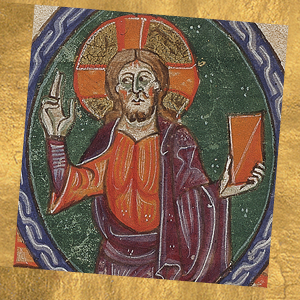St. Therese of the Child Jesus, Carmelite, Virgin Doctor of the Church, Patron of the Missions

To save Souls
Thérèse Françoise Marie Martin Alençon was born on January 2, 1873 to a couple of jewelers and watchmakers. They were deeply devout believers, “Worthy more of heaven than of Earth,” as Thérèse said of them. She was the last of eight children, three of whom died in childhood. Orphaned of her mother at the age of four, she relived the drama of abandonment as each of her four sisters in turn entered Carmelite life, though in return she received the particular affection of her father, who called her “Little Queen of France and Navarre”.
She entered the Carmel of Lisieux at the age of 15, by special permission of Pope Leo XIII, whom Thérèse himself had begged in Rome. “If God wills, you will enter,” was the Pope's response.
The girl's desire was to “save souls,” and above all “to pray in aid of priests.” Sister Theresa of the Child Jesus and of the Holy Face is the name she took at her profession. At the suggestion of her superiors, she immediately began to keep a diary, in which he noted the stages of her inner life. She wrote in 1895, “On June 9, the feast of the Most Holy Trinity, I have the grace to understand more than ever that Jesus wants to be loved.”
The “little way”
In France at the end of the nineteenth century, Positivist thinking was spreading, encouraged by the multiplication of great inventions and supported by anti-clerical and atheistic tendencies.
For this reason, Thérèse elaborated a highly original and powerful spirituality, called the "theology of the little way" or “spiritual childhood”, which bases the practice of love for God not on great actions, but in everyday - seemingly insignificant - acts.
In her autobiography, Thérèse writes, “There is only one thing to do: throw the flowers of the small sacrifices to Jesus.” And elsewhere, “I want to teach the little methods that have worked for me.”
In their original draft, this diary carries the subtitle, “The Story of the Springtime of a Little White Flower”. Beneath the whimsical appearance, however, there is actually a hard journey towards holiness marked by a strong response to God’s love for man.
Not understood by the sisters of the Carmel, Thérèse says she received “more thorns than roses” but accepts with patience the injustices and persecutions, as well as the pain and fatigue of illness, offering everything “for the needs of the Church,” in order, “to cast roses on all, the just and sinners.”
For John Paul II and Benedict XVI the specificity of her spirituality is its total openness to the invasion of God’s love, the capacity it engenders to respond to that love, even in the “night” of the spirit - for which Thérèse was a sister in this to sinners, the fallen away, atheists, the desperate - and for this, she was declared patron of missionaries.
Her death, and the “Story of a Soul”
After nine years of religious life, Thérèse died of tuberculosis at the age of only 24, on September 30, 1897. In 1923 she was beatified by Pope Pius XI, who considered her the “star of his pontificate” and then canonized in 1925.
In the 1950s, Abbé André Combes, theologian at the Institut Catholique, the Sorbonne of Paris, and the Lateran University, discovered manipulations that had been carried out in good faith on Thérèse’s Diary, by her Carmelite sisters, who were inclined to think of her as the their littlest sister and the darling of their house; the spiritual and theological doctrine of spiritual childhood, however, is not confined to a psychological and sentimental background made only of attention to small things. The heart of Thérèse’s spirituality resides in the awareness that man, even in his smallness, ends up divinized by Grace. In this Thérèse answers the “masters of suspicion” like Feuerbach, Marx, Freud, Nietzsche. The man-creature that lets the invasion of God’s love divinize him is not “alienated”: far from it. Christology and anthropology go hand in hand: Thérèse anticipated certain texts of the II Vatican Council and of Paul VI, as well as some passages of Benedict XVI’s Caritas in veritate, by nearly a century.







